#Alunite
Explore tagged Tumblr posts
Text
History recap year 1 : Alunite
This is an automated lander designed to go to mun and explore some craters. The mission went well except the end of the landing, In the slop, the lander tip over.
The engin was started to coreect the issue, but it hasn't work, so here it is stranded on mun.

1 note
·
View note
Text
Alunite Market Research Report: Regional Outlook and Market Share

The global alunite market has been steadily growing, driven by its diverse applications across various industries. Alunite, a hydrated aluminum potassium sulfate mineral, has found its place in industries such as agriculture, ceramics, water treatment, and more. This article delves into the current state of the alunite market, exploring key trends, drivers, challenges, and opportunities shaping its future.
Market Overview
Alunite, also known as alum stone, is primarily composed of hydrous aluminum sulfate, potassium sulfate, and other minerals. It is found in various geological formations, often associated with volcanic activity. Alunite is recognized for its use in diverse applications, making it a valuable commodity in the market.
Key Drivers of the Alunite Market
Agricultural Applications: Alunite is a source of potassium and sulfur, essential nutrients for plant growth. Its use as a soil conditioner and fertilizer enhancer has witnessed a steady rise, driven by the increasing demand for improved crop yields and agricultural productivity.
Water Treatment: Alunite's ability to remove impurities and clarify water has led to its adoption in water treatment plants. It is used in the coagulation process to purify drinking water and wastewater, which is crucial for public health and environmental protection.
Ceramics Industry: Alunite is a key ingredient in the production of high-quality ceramics and porcelain. Its presence in the ceramic industry has grown as manufacturers seek materials that enhance the strength, durability, and aesthetic appeal of their products.
Market Trends
Growing Environmental Concerns: With a focus on environmental sustainability, the alunite market has seen increased demand due to its role in wastewater treatment and reducing chemical pollution in soil. This trend is expected to continue as environmental regulations become stricter.
Technological Advancements: Advancements in mining and processing technologies have made it easier and more cost-effective to extract and refine alunite, further boosting its market growth.
Emerging Applications: Alunite is increasingly being explored for new applications, such as in the production of alumina, which has applications in the metallurgical industry, particularly in aluminum smelting.
Challenges in the Alunite Market
Geopolitical Factors: The availability of alunite deposits is not evenly distributed globally, and some regions face geopolitical challenges that can impact the supply chain. This can lead to price volatility and supply disruptions.
Competition from Alternatives: While alunite has unique properties, it faces competition from other potassium and sulfur sources, including synthetic fertilizers. Market players must continuously innovate to stay competitive.
Environmental Concerns: Despite its eco-friendly applications, the mining and processing of alunite can still have environmental impacts. Companies in the alunite market must address these concerns through sustainable practices.
Opportunities in the Alunite Market
Research and Development: Investing in research and development can lead to the discovery of new applications for alunite, expanding its market potential.
International Trade: Establishing international trade agreements can help secure a stable supply of alunite, reducing the impact of geopolitical challenges.
Sustainable Practices: Embracing sustainable mining and processing methods can enhance the reputation of alunite as an environmentally friendly resource, appealing to environmentally conscious consumers.
Conclusion
The alunite market demand is poised for growth, driven by its diverse applications and increasing awareness of environmental concerns. As industries seek sustainable solutions for agriculture, water treatment, and ceramics, alunite's role is set to expand. However, challenges related to geopolitics and competition necessitate proactive strategies from market players. By staying innovative and environmentally responsible, the alunite market can thrive in the evolving global landscape.
#Alunite Market Share#Alunite Market Growth#Alunite Market Demand#Alunite Market Trend#Alunite Market Analysis
0 notes
Text
SkyWing Names - Letter A #1
Ablaze (Burning fiercely, or something brightly colored.) Accentor (A dull-colored Eurasian songbird) Accipiter (A genus of medium-sized forest-dwelling hawks that have short broad wings and a long tail.) Achondrite (A stony meteorite without rounded grains) Acorn (Fruit of the oak tree.) Actinolite (A fibrous mineral that can be pale green, yellow, blue and black.) Adret (The sun-facing side of a mountain.) Adularia (A white or colorless mineral often found in the alps) Aegolius (A genus of small owls) Aerial (Of, relating to, or occurring in the air or atmosphere.) Aerie (A large nest of a bird of prey, especially eagles, typically built high in a tree or on a cliff.) Aerosol (Small particles suspended in the atmosphere.) Afterburn (A burning sensation.) Agate (A variety of chalcedony that comes in many colors, often with swirl or banded patterns throughout.) Aiguille (A sharp-pointed pinnacle of rock.) Airstream (A current of air.) Alabaster (A mineral often used for carving.) Alabio (An Indonesian duck breed.) Alate (To have wings or wing-like appendages.) Albite (A pale-colored, usually white, mineral.) Alder (A type of tree from the birch family with toothed leaves.) Alev (A Turkish name meaning 'flame'.) Alexornis (A prehistoric bird.) Algodonite (A copper arsenide mineral.) Alizarin (A red pigment.) Almandine (A type of garnet with a violet tint.) Alp (A high, rugged mountain that is often snowcapped.) Alpaca (A domesticated mammal related to the Llama and known for its wool.) Alpenglow (The rosy light of the setting or rising sun seen on high mountains.) Alpine (Relating to high mountains.) Altitude (The height of an object or point in relation to sea or ground level.) Alto or Altocumulus (A fleecy cloud formation that occurs at a medium altitude.) Altostratus (A fairly uniform mid-altitude layer of gray cloud.) Alunite (A white, gray, or reddish mineral that can be found in volcanic rocks.) Amaranth (A purple color.) Amaterasu (The Japanese Shinto goddess personifying the sun.) Amber (A hard and translucent fossilized resin, or a yellow/orange color.) Amblygonite (A pale yellow gem.) Amethyst (A violet or purple quartz gem or a violet color.) Ammolite (An opal-like gemstone made of the fossilized shells of ammonites.) Analcime (A white, gray or colorless mineral.) Anapaite (A green mineral.) Anatase (A rare gemstone that comes in many colors.) Andalusite (A gemstone that is typically brown, red or green.) Andes (A South American mountain range.) Andesine (A rare gem known for it's orange-red and red colors, but also comes in yellow, green, and blue.) Andesite (A gray lava rock with white and black speckling. The speckles are crystals such as feldspar or quartz.) Andradite (A kind of garnet that comes in many colors.) Angelite (A blue gemstone but can also be white, violet, colorless, or dark gray.)
#wings of fire#wof#wings of fire names#wof names#skywing#skywing names#fire names#bird names#rock names#mineral names#gemstone names#air names#tree names#names in other languages#red color names#landscape names#mountain animal names#cloud names#god/goddess names#a names
39 notes
·
View notes
Text
I think I'm slowly getting a picture of a narrative. This is tricky though. If I had uh- known what the fuck I was doing six months ago, I would've titled the presentation, "Alum mining, trade, and metallurgy from Bronze Age to Present" and called it a day.
The lax definition of alum's chemistry also makes it really hard to pin down. It ranges from hydrous to anhydrous (impure and pure) aluminum sulfate salt to aluminum clay. Civilizations until the Roman era just kind of pointed at white shit, called it alum, licked it to see if it was sour (not salt) and tossed it in the chemical vat.
There were also specific locales for the good shit. So instead of saying 'alunite', you'd say 'alum from the Hittites', or 'alum from Egypt'. One could be used for tanning, but the other was used for a fancy blue glaze (cobalt-clay). You could also produce alum from alunite, like on the isle of Lesbos (Sappho historical romance novel with alum when??)
But. Within all this. You have the Babylonians primarily using it as a tanning agent and wool-dyeing. The Egyptians used it as a glaze, for pottery, and medicinal/metallurgical uses. Apparently blue beads were making it all the way to China and Scandinavia at this time? The Romans took the metallurgical uses and cranked that up to 11. After the fall of Rome, the Arabs used alum for all the above and Germany was also using it metallurgically, but my research ends here right now.
In the present, alum is still used as a mordant (dyeing agent), but is more often used as a water treatment flocculant (filtering impurities). It's also more rigorously defined as either ammonium, potassium, or sodium hydrous aluminum sulfate. Whether we still mine it is unclear?? It doesn't seem to be the case: we mine aluminum, get aluminum oxide, which either goes to Iceland to be made into pure aluminum, or is sold separately and then added to Na2(SO4) to make alum.
It doesn't really pack the same punch I wanted it to with clothing though, because it's not really used for that. Chromium sulfate is now the primary mordant if you're doing chromium tanning, which is environmentally bad and kind of like nuking a hide to make it tan fast. I guess I can track down where the chromium is coming from, and how they make that.
This isn't even getting involved in plastic production, or rayon, or nylon, or the history of fast fashion and petroleum. I think the end line of this will have to be something vague and unspecific, like "disregarding the non-renewable resources that go into <I want to say artistic, but they're not artistic. The proper term is probably female-driven industries lol> fundamental human tools can lead us to overlook industries that have just as much impact - economically and socially - on geopolitics."
... I can already see the first question on that being, "what are some other non-renewable resources you think have been overlooked?" :') ahh, idk. I've been reading for 30hr. I'm going to go to sleep. I'll run away from the podium or smthg.
to do: I should reread Al-Razi with alum in mind... the translator is not Levey, so I have to chemically check all the names she gives minerals. But I distinctly remember alum coming up several times and tripping me up.
Also chromium sulfate manufacturing/mining; saving this chrome/ferric reference because I haven't seen them written altogether anywhere else.
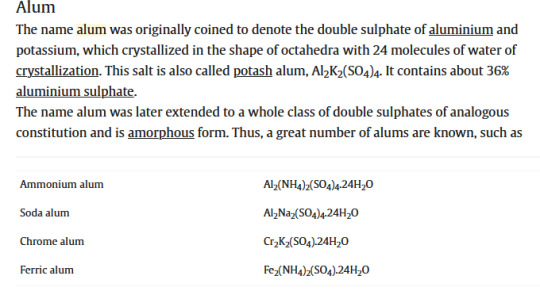
#I'm so tired but I'm a little closer than I was yesterday lol. That ending isn't terrible. Not great given what I planned to present#but very much still in the realm of my abstract and mining engineering.#That's kind of the chain on my wrist lol. I do still have to make this about mining engineering. There are a bunch of chemists here.#They are going to come to this presentation asking WHY clothing and ideally I still make the thing come back to mining engineering and#why systematic oppression under nonrenewable resource-driven industries matters.#Bits of my abstract from six months ago are popping into my head and making me laugh. I'm also technically supposed to cover the#/technology/ of all these civilization while /using/ alum. Oh... past!pulta you really got us in it now.#ptxt#alum#edit: actually zinc and lead oxide would make a really good 'underappreciated ancient nonrenewables' list.#Yeah lead was common af but it also made up the ancient world's pipe system and ho baby it's so sexy and fun.
12 notes
·
View notes
Text

HiPOD: Prospecting from Orbit
The combination of morphological and topographic information from stereo images, as well as compositional data from near-infrared spectroscopy has been proven to be a powerful tool for understanding the geology of Mars.
Beginning with the OMEGA instrument on the European Space Agency’s Mars Express orbiter in 2003, the surface of Mars has been examined at near-infrared wavelengths by imaging spectrometers that are capable of detecting specific minerals and mapping their spatial extent. The CRISM (Compact Reconnaissance Imaging Spectrometer for Mars) instrument on our orbiter is a visible/near-infrared imaging spectrometer, and the HiRISE camera works together with it to document the appearance of mineral deposits detected by this orbital prospecting.
Mawrth Vallis is one of the regions on Mars that has attracted much attention because of the nature and diversity of the minerals identified by these spectrometers. It is a large, ancient outflow channel on the margin of the Southern highlands and Northern lowlands. Both the OMEGA and CRISM instruments have detected clay minerals here that must have been deposited in a water-rich environment, probably more than 4 billion years ago. For this reason, Mawrth Vallis is one of the two candidate landing sites for the future Mars Express Rover Mission planned by the European Space Agency.
This image was targeted on a location where the CRISM instrument detected a specific mineral called alunite, KAl3(SO4)2(OH)6. Alunite is a hydrated aluminum potassium sulfate, a mineral that is notable because it must have been deposited in a wet acidic environment, rich in sulfuric acid. Our image shows that the deposit is bright and colorful, and extensively fractured. The width of the cutout is 1.2 kilometers. (Enhanced color cutout is less than 1 km across.)
ID: ESP_051153_2025 date: 25 June 2017 altitude: 284 km
NASA/JPL-Caltech/UArizona
39 notes
·
View notes
Note
I hope this is not a weird question, but does your surname come from the same word as alunite?
Haha! It doesn't.
Alunite is from the Latin "alumen"; bitter salt. And I am neither salty nor bitter.
69 notes
·
View notes
Note
A? is that short for the amphibole or alunite group?

6 notes
·
View notes
Note
Hi, I am new here. Could you please suggest me people to follow here?
And i am curious to know how did you get into learning about islam? Are you religious person?
@alunit @bakwaaas @eatingfood @haidarism @kismili @malieck @nehmesis @peachyarht @saorsaen @weltenwellen @windblownleaf here you go!
Yes, I am a religious person, I like to call myself a monotheist. I was a practicing catholic and then an atheist before I started learning about islam in university (I did my bachelor in philosophy and oriental studies). I think it's a beautiful religion.
Thank you for your question, anon, and take care!
4 notes
·
View notes
Text


My partner got me back into steven universe, so I redesigned some really old gem characters for the hell of it. the one on the left is still kind of nameless? He's a redesign of my black diamond, but I've kind of scrapped his old backstory, so now idk if I even want him to still be a diamond? It's to be determined~ at the moment, I'm playing with the idea of him just being a really messed up out of shape gem. Like how majority of gems in the show come out with a cut and facet, they're all polished jewelers quality gemstones. This guy is a rough, totally uncut rock. The right guy however is a redesign of lightning alunite, or red alunite. he was originally out of a now abandoned deviant art group where gems were based off of old grim brothers style stories as well as folk tales from around the world. Lighting came from a story of lightning and thunder originally. I mainly kept the bolts and stormy greys from his original design. But totally swapped his personality and horns. this guy went from a tough jock to probably the most flamboyant man you'll ever meet.
5 notes
·
View notes
Text

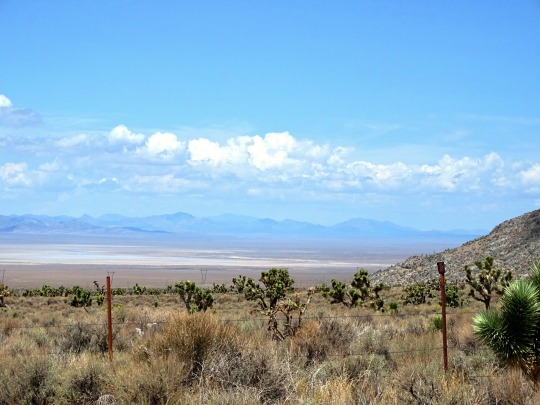
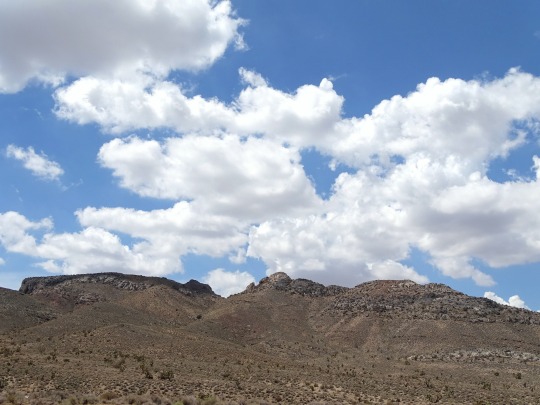



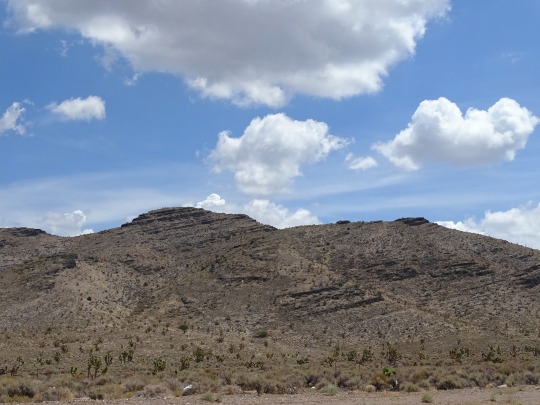
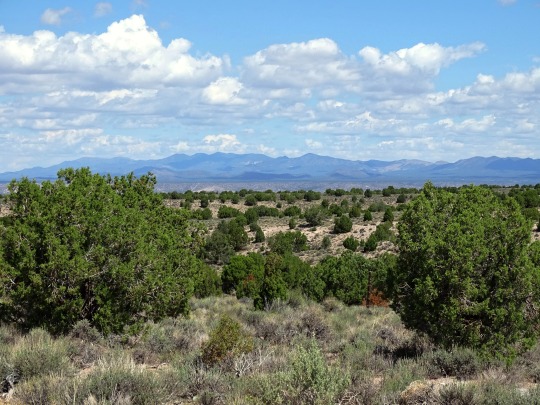


Great Basin Highway, NV (No. 2)
U.S. Route 93 was not one of the original U.S. highways proposed in the 1925 Bureau of Public Roads plan. However, the revised numbering plan approved by the American Association of State Highway Officials (AASHO) on November 11, 1926 established US 93 from the Canada–US border near Eureka, Montana south through Montana and Idaho to a southern terminus at Wells, Nevada. The establishment of the highway was reflected on Nevada's 1927 official highway map. The Nevada section was approximately 70 miles (110 km), commissioned along what was then the northern portion of State Route 13.
After US 93 was extended to Arizona in the 1930s, the route remained unchanged for many years. A 19-mile (31 km) concurrency with U.S. Route 95 between Las Vegas and Alunite was added in 1940, when that highway was extended through southern Nevada along State Route 5.
The first major shift of US 93 occurred in 1967, when a new highway connection was completed between US 91 (now I-15) and a point 24 miles (39 km) northwest of Glendale. The new alignment was oriented more north–south, shortening the distance between the Las Vegas area and Caliente by 23 miles (37 km). The old section of US 93 northwest of Glendale paralleling the Muddy River remained as State Route 7, and was renumbered in 1976 to State Route 168.
Source: Wikipedia
#Caliente#Lincoln County#Great Basin Highway#Highway 93#Joshua Tree#desert#travel#original photography#vacation#tourist attraction#landmark#landscape#countryside#flora#bush#street scene#summer 2022#USA#US 93#US Route 93#mountains#hills#fence#blue sky#clouds
2 notes
·
View notes
Text

𝓢𝓹𝓸𝓷𝓼𝓸𝓻𝓼 ✨ GALAGHER || LEXA || VIPERA
Galagher - Della Fatpack
🌸 Compatible with: 🌸 Legacy+Perky 🌸 LaraX 🌸 Reborn
📌 GALAGHER STORE 🏷️✨ https://maps.secondlife.com/secondlife/Hollow%20Creek/48/215/3901
Lexa - Alunite Needle Nails
🌸 Compatible with Mesh bodies: 🌸 Ebody Reborn 🌸 Legacy 🌸 Maitreya 🌸 Kupra
📌 DUBAI EVENT 🏷️✨ https://maps.secondlife.com/secondlife/Horizon%20Beach/126/133/22
[VIPERA] Desire Bracelets
🌸 Rigged mesh bracelets for: 🌸 eBody Reborn 🌸 Inithium Kupra 🌸 Legacy 🌸 Maitreya LaraX 🌸 Peach
🌸 + Unrigged mesh bracelets (left and right)
🌸 Resizable on hud 🌸 HUD for color changing: 🌸 Metals: 8 colors 🌸 Gems 1: 9 colors 🌸 Gems 2: 9 colors
🌸SHOW/HIDE parts of the set
📌 VIPERA STORE 🏷️✨ https://maps.secondlife.com/secondlife/Utopia%20Isles/155/143/3977?_gl=117r1ohc_gaODgyNzY2OTE5LjE2NDU0MTEyMjM._ga_T7G7P6DCECMTcwNjE0MDc1OC41OTIuMS4xNzA2MTQ1NDA4LjAuMC4w_fplc*TnNaNnZiRW1GbXpHSHVKWHlvZjZxSFI4YWs3eHE0bmpRUW1pRG9DSHkyMmZIU1FPNCUyRkRWdm5BdTJub2dsNU5pMCUyQmhrVDBZJTJGRldrdlMwJTJCMm1odTVrZXk0VURrbkFkRm1ZaVJjNjI4V0ZEMHJUTjg4JTJGdm5KemFPZlN0ZEdCQSUzRCUzRA..
📸 𝓢𝓸𝓬𝓲𝓪𝓵 𝓝𝓮𝓽𝔀𝓸𝓻𝓴𝓼 𝓢𝓽𝓸𝓻𝓮𝓼 📸
LINKS GALAGHER:
MARKETPLACE: https://marketplace.secondlife.com/pt-BR/stores/215698
LANDMARK: https://maps.secondlife.com/secondlife/Hollow%20Creek/48/215/3901
STORE SOCIAL NETWORKS GALAGHER:
FLICKR: https://www.flickr.com/photos/162355913@N04/
FACEBOOK: https://www.facebook.com/profile.php?id=100088343984730
LINKS LEXA COSMETICS:
MARKETPLACE: https://marketplace.secondlife.com/stores/234786
LANDMARK: http://maps.secondlife.com/secondlife/Blue%20Nightclub/176/115/4002
STORE SOCIAL NETWORKS LEXA COSMETICS:
FLICKR: https://www.flickr.com/photos/156966250@N05/?fbclid=IwZXh0bgNhZW0CMTAAAR1n1mXYn4oMlTppc5gl3Rd8_hkdhoW-DcIG7moKHj6JRC8AIZpc9QKc6oY_aem_AWW8qptA-I3WIE20JhNwQEgZgJFDFwNbiQz7suVKluF-2E_G237IqI4PTz__IItiyz4GsSvYhbvjCpi6I3RprOUw
FLICKR GROUP: https://www.flickr.com/groups/14778936@N21/pool/with/53666918795
FACEBOOK: https://www.facebook.com/LexaStoreSL
FACEBOOK: https://www.facebook.com/groups/1451258911552900/user/100062228202907/
LINKS VIPERA:
MARKETPLACE: https://marketplace.secondlife.com/stores/24996?fbclid=IwAR1Vy5s27shsuoFNAUgVIJ85BL3C-DGjFWFT9Sd7HNeiJbICDhn1JEcR8jw&page=2
LANDMARK: https://maps.secondlife.com/secondlife/Utopia%20Isles/155/143/3977?_gl=117r1ohc_gaODgyNzY2OTE5LjE2NDU0MTEyMjM._ga_T7G7P6DCECMTcwNjE0MDc1OC41OTIuMS4xNzA2MTQ1NDA4LjAuMC4w_fplc*TnNaNnZiRW1GbXpHSHVKWHlvZjZxSFI4YWs3eHE0bmpRUW1pRG9DSHkyMmZIU1FPNCUyRkRWdm5BdTJub2dsNU5pMCUyQmhrVDBZJTJGRldrdlMwJTJCMm1odTVrZXk0VURrbkFkRm1ZaVJjNjI4V0ZEMHJUTjg4JTJGdm5KemFPZlN0ZEdCQSUzRCUzRA..
STORE SOCIAL NETWORKS VIPERA:
FLICKR: https://www.flickr.com/photos/viperasl/
📸 𝓜𝔂 𝓢𝓸𝓬𝓲𝓪𝓵 𝓝𝓮𝓽𝔀𝓸𝓻𝓴𝓼 📸
✨📸 𝓑𝓛𝓞𝓖 📸✨ https://www.tumblr.com/blog/madisondaft
✨📸 𝓕𝓑 📸✨ https://www.facebook.com/profile.php?id=100056900617765
✨📸 𝓘𝓖 📸✨ https://www.instagram.com/madisonhdaft/
0 notes
Text
Alunite Market Expansion Strategies: From Mining to Manufacturing

The global Alunite market is currently experiencing significant growth and is poised to continue on an upward trajectory in the coming years. Alunite, a naturally occurring mineral, has found applications in various industries, including agriculture, water treatment, and cosmetics. This article explores the Alunite market, its key drivers, challenges, and potential growth opportunities.
Market Overview
Alunite market, an aluminum potassium sulfate mineral, is primarily found in volcanic rocks and has been used for centuries in traditional medicine and as a source of alum. In recent years, its applications have expanded beyond traditional uses to various industries, including agriculture, where it is utilized as a slow-release fertilizer, and water treatment, for its ability to remove contaminants.
Key Drivers of the Alunite Market
Growing Agriculture Industry: The agriculture sector is a major consumer of Alunite due to its effectiveness as a slow-release fertilizer. As global food demand continues to rise, farmers are increasingly turning to Alunite to enhance crop yield and quality.
Environmental Concerns: Alunite's eco-friendly and non-toxic nature makes it an attractive choice for water treatment applications. As environmental regulations become stricter, the demand for sustainable water treatment solutions is on the rise, driving the Alunite market.
Cosmetics Industry: Alunite is gaining popularity in the cosmetics industry for its skin-friendly properties. It is used in skincare products for its astringent and anti-inflammatory properties, adding to the market's growth.
Challenges
Despite the positive outlook, the Alunite market does face some challenges:
Limited Availability: Alunite deposits are not as abundant as other minerals, which can lead to supply shortages and price fluctuations.
Competing Technologies: In the water treatment sector, Alunite competes with other materials and technologies, such as activated carbon and membrane filtration.
Research and Development: To unlock the full potential of Alunite in various applications, ongoing research and development efforts are required, which can be costly and time-consuming.
Market Segmentation
The Alunite market can be segmented based on its applications:
Agriculture: Alunite is used as a slow-release fertilizer, promoting healthy plant growth and improving soil quality.
Water Treatment: Its adsorption properties make Alunite an effective material for removing contaminants like heavy metals from water sources.
Cosmetics: Alunite is used in skincare products for its astringent, exfoliating, and anti-inflammatory properties.
Others: Alunite also finds applications in the production of alum, pharmaceuticals, and as a flame retardant in the manufacturing of fire-resistant materials.
Regional Outlook
The Alunite market's growth is not evenly distributed across regions. It is driven by factors such as industrialization, agriculture practices, and environmental regulations. Some regions to watch include:
North America: With stringent environmental regulations and a growing interest in sustainable farming practices, the North American market for Alunite is expected to expand.
Asia-Pacific: The increasing demand for food, coupled with a growing population, makes Asia-Pacific a promising market for Alunite in agriculture.
Europe: Europe is expected to witness growth in Alunite applications in the cosmetics and water treatment sectors due to its focus on sustainability and water quality.
Conclusion
The Alunite market presents numerous growth opportunities driven by its diverse applications and eco-friendly properties. While challenges like limited availability and competition exist, ongoing research and development efforts can help overcome these obstacles. As industries continue to seek sustainable solutions, Alunite's role in agriculture, water treatment, cosmetics, and beyond is likely to expand, making it an exciting market to watch in the coming years.
#Alunite Market Share#Alunite Market Growth#Alunite Market Demand#Alunite Market Trend#Alunite Market Analysis
0 notes
Text
0 notes
Text
My head's about to fucking explode so I'm going to rubber duck tumblr
You can essentially have four fluid components when you're dealing with ore deposits. (this is grossly simplified). You can have alkaline fluid, or sulfuric fluid. And highly oxygenated fluid or reduced/high sulfidation fluid.
When you have alkaline fluids, 9/10 times you're dealing with terrestrial fluid infiltration/interaction rather than a magmatic fluid, unless you're working with carbonatites, in which case god help you.
When you have Au systems, Au can be carried by Cl or H2S, so it's a lot of one or the other, so you have to rely on the minerals around it for ID.
Goldfield was advanced argyllic which forms at almost every temperature with high acidity and low K content.
Which probably means it wasn't magmatically driven? but epithermal? but with low Cl????????? but high enough S content the magma had an influence?? High oxidation if we're getting alunite which is SO4??? But we're not getting sulFIDE mineralization so low S2.
Or was the acid being driven by H20 depressurization???
If you have KSO4 it makes to be a high oxidation state along with quartz because the potassium is still trying to escape but it's creating weird minerals rather than potassium feldspar. The As and Sb also tell you it's HS driven.
2 notes
·
View notes
Text

PROMO MURAH 11.11 TAWAS BUBUK 0813-3535-3290
Tawas bubuk adalah suatu bahan kimia yang sering digunakan sebagai antiperspirant atau deodoran alami. Bubuk tawas biasanya terbuat dari garam kalium alum, yang diekstraksi dari mineral alunite. Bubuk tawas memiliki sifat yang dapat mengurangi produksi keringat dan menghambat pertumbuhan bakteri yang menyebabkan bau badan.
info link pembelian shoope = https://shopee.co.id/Tawas-Kristal-Penjernih-Air-1-Kg-i.749609936.22248843469?sp_atk=153bde0f-ce2c-4f1a-87ed-8345829b7be8&xptdk=153bde0f-ce2c-4f1a-87ed-8345829b7be8
Info nomor whatsapp perusahaan wa.me//0813-3535-3290
Alamat Perusahaan Jl. Raya Jakarta-Bogor, Pabuaran, Kec. Cibinong, Kabupaten Bogor, Jawa Barat 16916 https://maps.app.goo.gl/mrwNHdQEhALnAHJz9
tawas,manfaat tawas,tawas kristal,tawas adalalah,kegunaan tawas
tawas #tawaskristal #fungsitawas #manfaattawas
0 notes
Text
Alunite is a mineral composed of hydrated potassium aluminum sulfate, often used in making ceramic glazes. It is often referred to as "Sassinite" or "Porphyryite." Alunite is carefully handled because it can be toxic if inhaled in dust form. According to the American Conference of Governmental Industrial Hygienists, exposure to high concentrations of airborne alunite can cause irritation of the respiratory system, and even cause physical damage to the lungs. When working with alunite, proper safety measures must be taken to prevent inhalation of dust particles.
It is also important to take precautions when handling alunite due to its reactivity. By adding water to alunite, the mineral can release sulfuric acid. When exposed to a strong sulfuric acid, skin, metal, and other materials can be corroded. For this reason, those working with alunite should always wear protective gloves, clothing and eye protection.
In addition, alunite produces toxic gases when heated, which can cause serious health complications if inhaled. Therefore, it is recommended to use proper ventilation and to wear a respirator when working with alunite or applying it as a glaze.
Overall, alunite is carefully handled because of its reactivity, inhalation hazards, and potential to cause harm if heated. Such caution is necessary in order to prevent exposure and protect workers from potential harm.
0 notes